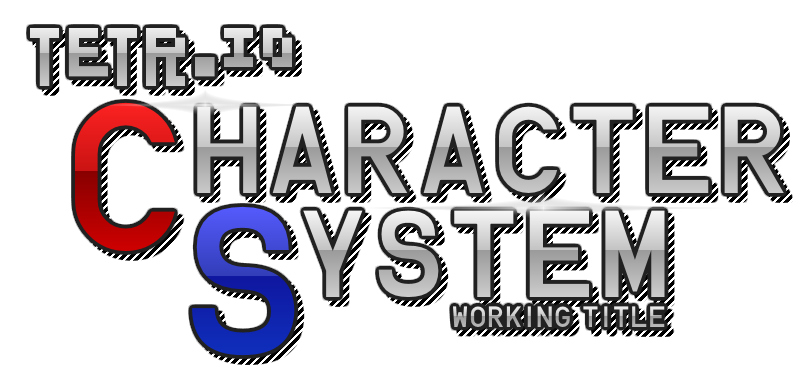



The TETR.IO character update is a complete overhaul of how 1v1 games are played at all levels. More specifically, it will add playable characters to the game that have their own unique skills, strengths and playstyles. It is being made in an effort to enrich the VS stacker experience in many ways, both gameplay wise and community wise.
The TETR.IO character update is a collaboration between TETR.IO developer osk and community member / streamer Garbo. If you have a question (that isn't answered in this document), you can either DM us (osk and Garbo#0001 respectively) or check out the special Character System discussion thread on the TETR.IO Discord.
There's many fundamental issues with the execution of modern VS stackers which have gone unaddressed for years. By fundamental, we mean issues that can not be fixed by adjusting numbers because the foundation that lies below it is problematic. The only way to fix fundamental issues would be to change the foundation, and we've found that a complete overhaul through characters is an extremely effective way of addressing this. Here's a list of some of the main objectives we've set out to focus on:
In a multiplayer game, especially a competitive one, being able to play around what an opponent does and having both players' decisions influence each other is a given. However, due to the abstract nature of stacker games and their singleplayer origins, they tend to lack any real interaction. In the character update, there are decisions such as when to use an ability or how to play around your opponent's active, which create more direct interactions between players. Another big part of interaction is being able to punish, which is the ability to act on an opponent's mistake. In current iterations of the game, if you spot your opponent taking a very greedy T-spin or stacking poorly, you would try and send as much as you can to them, which is probably the action you would've taken anyways.
One of the most common praises of stacker games is that they are very simple yet very deep. However in practice, there is actually a deceptively little amount of depth that goes into the game. The decision making follows a simple loop of sending as much as you can and downstacking to avoid danger. Of course, stacking clean, downstacking well and having all of your moves elegantly chain together is important, but the reason you make those decisions is lacking in variance. In the character update, we've added many different actions with their own risks and rewards, which would make it so that there's a wealth of options to consider rather than trying to beat your opponent down with more attack.
This is less of a problem with modern stackers, since there are many games able to function well without overarching strategy. However, we believe that it's a great way to enhance it. For example, if you know your character is good early but does not scale well into the late game, you can plan to win at a certain level and prepare for that, and if that plan goes under, you'll have to consider whether to recklessly push forward to double down on the original plan or retreat to stay caught up in levels. Another example would be if you plan on winning late, but your opponent makes a bad misdrop. If you try and capitalize on it, you could steal a quick win, but if it goes poorly it could stifle your pace and jeopardize your original plan. To put it more concisely, the goal is to have macro strategies with a good balance of planning and improvisation.
The "win condition" of modern VS stackers is relatively simple — push the opponent out of the field. However, the path to this win condition is always rather vague, and often ends up boiling down to "just keep playing until you either win or lose". You often don't even know if you're going to win, no matter what you do — there's usually never a decisive strike, but rather a death by a thousand papercuts, even if some of those are intended to kill. The character system will have more defined, clearer win conditions, giving you true strategies and methods to attain a win, by building an advantage and using your abilities to deliver a killing blow and send your opponent off the screen. On the other hand, it also allows you to play around your opponent's win conditions, ensuring you thwart your enemy's plans, causing a lot of strategic plays. Having clear win conditions not only allows for more strategic plays, but also makes it easier for beginner players to work toward a victory, by showing a more defined path to victory.
In pretty much all competitive games, when somebody is playing better than their opponent they will gain an advantage. This simply means that because they have been outplaying their opponent, they have a higher chance to win that round. The advantage in current modern VS stackers usually comes from the set count, where a Tetra League match can have someone winning by score. However, within a round the only garbage line that matters is the one that tops the opponent out, and everything else can be downstacked and the state of the game can be reset back to square one. This isn't nearly as relevant to lower rating games, but as you go higher in rank it becomes more and more of a problem. If you can get your opponent into a tough spot in the character system, you can gain a level advantage on your opponent or charge your active while they're stuck downstacking, but you can still also try to kill them if you're feeling confident. In short, there's more options to gain an advantage over your opponent that are more concrete and lasting than lines on their board.
Due to the simplicity of the genre (and the "Guideline" most games follow), most stacker games currently are relatively similar. The character update hopes to make the game more recognizable, and adds more personality onto a very simple canvas. The game can be made into a very great viewing experience, by adding more strategy into the game, with high and low points to keep you on your toes — differing from the current playstyle, which mostly consists of repeatedly downstacking the enemy's attacks back and forth, which is not as interesting as it could be. Updates can bring a steady flow of improvements and changes to keep the game fresh as time passes. On top of that, the concept of characters in general will cause a lot of interesting developments — people may draw fanart (like the art of the characters you see around this page, drawn by @largeonions) or otherwise add their own creative spin on the game's content!
In current modern VS stackers, most games end up looking and playing very similar, since the playstyle of all the players is very similar, as everyone plays under the exact same rules, with not much distinction between people's interpretations of said rules. The character update brings highly varied playstyles to every character and people's interpretations of said characters, as well as the countless interactions between them. Since all the characters are different and leave a lot of room for strategy, there's many different ways to play the game, depending on the character you pick and your own skills. That way, every round is different from the ones before it and feels fresh. This not only makes the game more entertaining to watch and play, but also gives you more room to express yourself and your skills ingame!
We currently intend to launch this system alongside the current Tetra League. We might rename the old Tetra League to a new name (e.g. Classic League). In an older revision of this document, we stated our intent to replace Tetra League with this system. This is no longer deemed to be needed with the current state of the game. That said, we do intend to reset Tetra League rankings as well, as we intend to make more common changes to it as well (nothing as out there as Character System, but changing the game to fit the playerbase is key to upkeeping a healthy game).
We cannot give an absolute ETA just yet. Don't expect it tomorrow morning, there's still a lot of work to be done before this system can be implemented — we'll keep you up to date on the progress!
While it is true that there's a lot to take in, at lower rank games you'll find that since people aren't as good at countering and playing around abilities, charging actives would give a clear goal such as "charge by clearing 3 quads" and the payoff would be big. This can kind of streamline the experience since the current game plan at lower ranks would just be to survive longer than your opponent at all costs.
Since this system is intended to the competitive mode, testing is very important here! This system will undergo multiple phases of rigorous testing across all skill levels. Generally, the system will first undergo private testing to debug the system, then slowly become more public, in an INFDEV-like testing phase (although applications to join will be vetted to ensure quality feedback). Once it truly launches to the public, you can be ensured that it has been tested rigorously!
This system is generally geared towards a 1v1 environment, so it will not be used in Quick Play or custom rooms by default. You will be able to switch it on in custom rooms, and tweak some options for the system there too. At a later moment, we may look into making a mode geared towards more than 2 players, but it's not currently in the scope of the system.
The character system update will effectively act as a new "season" of Tetra League. Your TR will be reset and you will have to redo placements. However, your old rank and statistics will be displayed on your profile, and the leaderboards of the previous season will remain viewable on Tetra Channel.
Yes, if we believe a character has good potential, we may add it into the game! We'll take good care once again then to ensure any additions are tested and robust.
Nothing on this page is final. Elements, characters, names, graphics, UI/UX, numbers, mechanics etc. may be added, changed, amended, or even scrapped altogether. This documentation is only to display an in-depth view of what we're working on, and does not give any indication of any potential final product.
This page is majorly outdated. Many elements described have been altered majorly since writing, and are being developed and tested in private. Please stay tuned for further information!
On release, there will be 8 characters to choose from. Each character has their own unique playstyle and set of abilities. We've also revamped the garbage tables and added new systems to give the game lots of depth. Below, you'll find documentation where you can read about how everything works.
 If it's not obvious enough yet, none of this is final, especially the specific numbers associated. Testing still has to be done!
If it's not obvious enough yet, none of this is final, especially the specific numbers associated. Testing still has to be done!
Each character has 2 skills: a  passive and an
passive and an  active. The passive is something that's constantly running and greatly influences what you stack for and how you play. The active is an ability which compliments your character's playstyle and can be activated with a new "active ability" button. Each active has their own requirements to be charged such as "clear 3 quads" or "block 10 lines".
active. The passive is something that's constantly running and greatly influences what you stack for and how you play. The active is an ability which compliments your character's playstyle and can be activated with a new "active ability" button. Each active has their own requirements to be charged such as "clear 3 quads" or "block 10 lines".
Alongside this, you will have a character level. Each round will start with both players at level 1, and over the course of the game you can go up to a maximum of level 10. By outplaying your opponent, you can gain a level advantage that will give you an edge. Here's how it works:
At the start of each round, both players start at level 1. Over the course of the round, you'll become stronger as you level up. Here's a table listing the level information:
 Table data, like all other aspects, is not final.
Table data, like all other aspects, is not final.
| Level | XP required | Buff name | Description |
|---|---|---|---|
| 1 | 0 | N/A | Base table of singles, doubles, triples, quad Combo and B2B T-Spins send 1■/line Skill Tier I |
| 2 | 6 | T-Spin Power UP! | T-Spins start sending 2■/line |
| 3 | 12 (18 total) | Skill Tier II | Skill Tier II |
| 4 | 18 (36 total) | Combo Spiking | Quads and T-Spins in a 2-combo or higher send +1■ |
| 5 | 24 (60 total) | Improved B2B | The bonus sent by B2B is its own attack (so B2B TSD sends 4+1■ instead of 5■) |
| 6 | 30 (84 total) | Skill Tier III | Skill Tier III |
| 7 | 36 (120 total) | Improved Triples | Triples send 1+1■ as opposed to 2■ |
| 8 | 42 (162 total) | Quad Power UP! | Quads send 5■ |
| 9 | 48 (210 total) | Skill Tier IV | Skill Tier IV |
| 10 | 54 (264 total) | ALL POWER UP! | Whenever you attack, send an additional seperate 1■ (example: double would send 1+1■ and B2B quad would send 5+1+1■) |
 Most people won't need to remember this table - the ingame UI will make it obvious enough.
Most people won't need to remember this table - the ingame UI will make it obvious enough.






Whenever you send lines, they will also add into your "Stored Lines" bar (to the right of the XP bar below the board). Over time, your stored lines will naturally be converted into XP (current rate is 0.2 XP/s but it's highly subject to change). You can store a total of 8 lines at once — excess is discarded. Therefore, for full effiency, you'd need to be converting your stored lines every 8 lines.
 Numbers given and imagery for illustration purposes only.
Numbers given and imagery for illustration purposes only.






A faster way to convert stored lines. If you don't drop pieces for 2 seconds, gravity stops, you'll instantly convert 2 stored lines into XP and you'll also start converting at a rate of 2 XP/s until focus ends (thus, emptying a full gauge would take 5 seconds, including time before focus kicks in). Focus ends when you place a piece, or you're out of stored lines.
 Numbers given and imagery for illustration purposes only.
Numbers given and imagery for illustration purposes only.
As you might have seen in the levelling table, there are 4 skill tiers (I, II, III, IV). Each character will have their own scaling on passive and/or active skills. In short, a buff unique to your character.
In terms of how this plays out, there is now a clear advantage to be gained through level, and in order to get ahead you have to shoulder the corresponding risk. At lower levels where players play slower and less efficiently, the difficulty of levelling would be gaining stored lines and in higher level play the difficulty becomes that it's harder to find opportunities to focus. You can also strategize around your opponent's level and when they're strongest. If your opponent scales better, you can probably expect them to aggressively level and a good plan would be to punish their use of focus, but if you scale better, it's a good plan to set yourself up for opportunities to focus. In short, the goals here are for there to be clear advantage, and in order to come back from being behind, you need to outplay your opponent rather than just downstack.
Here are some of the characters that we are currently planning on having in the game, so you can get an idea of what to expect.
(1, 2, 3, 4) — notation for a scaling value at each skill tier
1x4 lines - A multi-hit attack. Can also be notated as 1+1+1+1. Example:
| 4■ | 2x2■ (or 2+2■) | 1x4■ (or 1+1+1+1■) |
|---|---|---|
 |
 |
 |
■/l — Garbage lines sent per line cleared
 Characters, character illustrations, character names, character abilities, character ability numbers etc. not final.
Characters, character illustrations, character names, character abilities, character ability numbers etc. not final.
 These characters' names are temporary "working names" and will be changed later on.
These characters' names are temporary "working names" and will be changed later on.


DIFFICULTY★
 PASSIVE
PASSIVE
Is not rewarded for regular clears. Combo table is replaced with sending a bonus 4 lines every (6, 5, 4, 3) clears in a combo.
 ACTIVE
ACTIVE
Remove your opponent's next I-piece (outside of their visible queue) and gain it as your current piece. If you score a quad using the stolen I-piece, steal half of your opponent's stored lines.
 Charge by clearing 4 quads
Charge by clearing 4 quads CREATORS' NOTES
CREATORS' NOTESSo this is kind of the quintessential noob character. You charge by clearing quads and it heavily punishes opponents for inflexible stacking. However, where this character loses out is if your opponent is controlling the garbage better, since you don't have many ways to deal with cheese. Also, your passive is not very good early game, so a skilled player will try to capitalize on this. With that being said, this character will have interesting play in higher rank games when it comes to controlling the board and keeping pace by stealing stored lines using Piece Theft in hopes to make it to late game.
 Character and character kit not final.
Character and character kit not final.

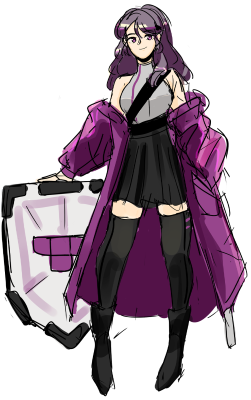
DIFFICULTY★★
 PASSIVE
PASSIVE
Your attacks now build a shield instead of sending. The shield blocks incoming attacks before they reach the garbage queue. When you place a block that does not clear a line, release your shield and send its remaining power as an attack.
 ACTIVE
ACTIVE
Gain a (1, 2, 4, 5) line Aegis shield and for 10 seconds, up to that amount won't be released by placing a block that doesn't clear. Unbreakable will prematurely end if you receive garbage. If you make it through the whole 10 seconds, inject 3 unclearable garbage to your opponent.
 Charge by blocking 8■ using Aegis
Charge by blocking 8■ using Aegis CREATORS' NOTES
CREATORS' NOTESThis is probably the crowd favorite so far when it comes to kit design. They have a very macro-heavy style where punishing your opponent and choosing when to block/send are crucial. You can upstack a T-Spin setup to get a large shield and then use Unbreakable to hide behind it, or use Unbreakable when you see your opponent’s stack in a compromised state. If your opponent has unclearable garbage, they'll have less headroom to level up and you can slowly shift the game in your favor. However, failing Unbreakable sets you back far since you needed to block lines to charge it. A victory playing this character will come from winning a set of smaller battles and slowly edging the odds in your favor, and there's a ton of potential with that concept and it'll be interesting to see as more people get to explore this style.
 Character and character kit not final.
Character and character kit not final.

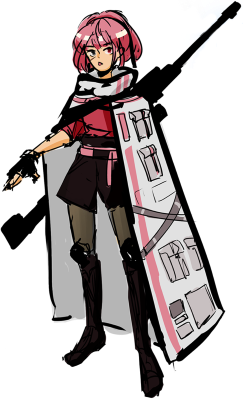
DIFFICULTY★★
 PASSIVE
PASSIVE
You can now perform mixed clears. Mixed clears send (+1■, +1x1■, +1x2■, +1x3■) lines.
 ACTIVE
ACTIVE
You can hold up to 3 charges of Snipe. When activated, consume all of your charges and inject 2■ per charge after a 1.5 second windup.
 Charge by clearing 4 mixed clears (per 1 charge).
Charge by clearing 4 mixed clears (per 1 charge). CREATORS' NOTES
CREATORS' NOTESSo at the core of this character's design lies a forgotten style of downstacking known as "blockbox downstack". In modern games with big combo tables and little to no delays, this style has been pushed out by the much more viable downstack combo. Blockbox downstacking is a mix of upstacking and downstacking which cheeses an opponent while getting down. In order to revive it, we created the mixed clear for some extra cheesing power. To go along with that theme, a common problem with cheese garbage centered play is that since both players will be exchanging cheese, it can be hard to get enough power for a game winning spike. This character can work around this problem by using Snipe, which you can use to spike your opponent out when the time is right due to the ability to cast it at any time with very little windup.
 Character and character kit not final.
Character and character kit not final.

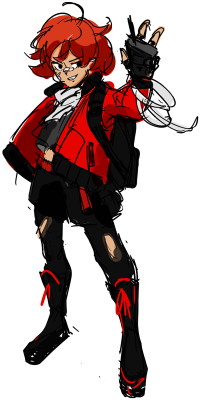
DIFFICULTY★★★
 PASSIVE
PASSIVE
Your T-Spins now send as mines and send (+1■, +2■, +(1■/l+1), +(1■/l+2)) more
 ACTIVE
ACTIVE
After a 5 second countdown, detonate all of the mines you sent (including mines sent during the countdown), turning them into regular lines and sending their stored amounts. During the countdown, your mines will not detonate when cleared.
 Charge by 6 mines being sent and/or 6 of your sent mines being triggered (each contributes +1 to the charge)
Charge by 6 mines being sent and/or 6 of your sent mines being triggered (each contributes +1 to the charge) CREATORS' NOTES
CREATORS' NOTESMines are an interesting concept. You take the pressure of clean garbage, but compact them down so they don't spike as hard. This character takes a lot of the screenwatching elements from the shield character and makes them more precise. Since your mines get defused if they are cleared during Countdown, you'll have to be able to roughly estimate how long it'll take for your opponent to downstack. However, if you can make sure your mines will be safe for the next 5 seconds, the payoff is huge. This is a character that will have to be tuned a lot over time to get that risk and reward balance just right, but if done correctly it can add a ton of skill expression and strategy to pressure and spiking.
 Character and character kit not final.
Character and character kit not final.

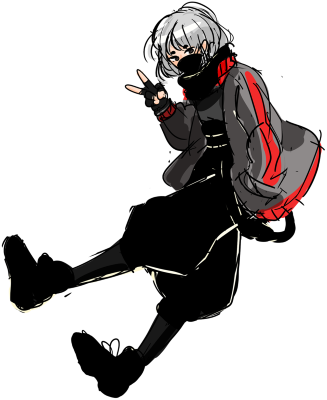
DIFFICULTY★★★
 PASSIVE
PASSIVE
You can now perform color clears. Color clears send (2x2■, 2x3■, 2x4■, 2x5■) garbage to your opponent and inject 1 yellow colored line to yourself.
 ACTIVE
ACTIVE
Only usable when you have a yellow line on the board. Aligns all garbage above the yellow line to its hole.
 Charge by clearing 2 yellow lines. Starts the game with 1/2 charge.
Charge by clearing 2 yellow lines. Starts the game with 1/2 charge. CREATORS' NOTES
CREATORS' NOTESAdmittedly, this character is way too ahead of its time. Since color clearing has never been rewarded in any game before, chances are that nobody will be able to play them well for a while. However, at its core, color clearing has a lot of cool stuff that you can do with it. It's like a PC on steroids since you can do it anywhere and also skim off pieces into your garbage to manipulate your parity or amount of odd/even blocks. To make things more interesting, we've tied your ability to color clear effectively with your ability to downstack quickly, since you must clear the yellow line before getting another color clear. There's also a ton of room for playmaking and skill expression using the active, which if used correctly can chain color clears back to back and sweep through large amounts of messy garbage. For color clear research, we've enlisted the help of Jstris PC mode world record holder and former Blitz world record holder JimothyJimothy, and we're looking forward to seeing what cool stuff is possible!
 Character and character kit not final.
Character and character kit not final.